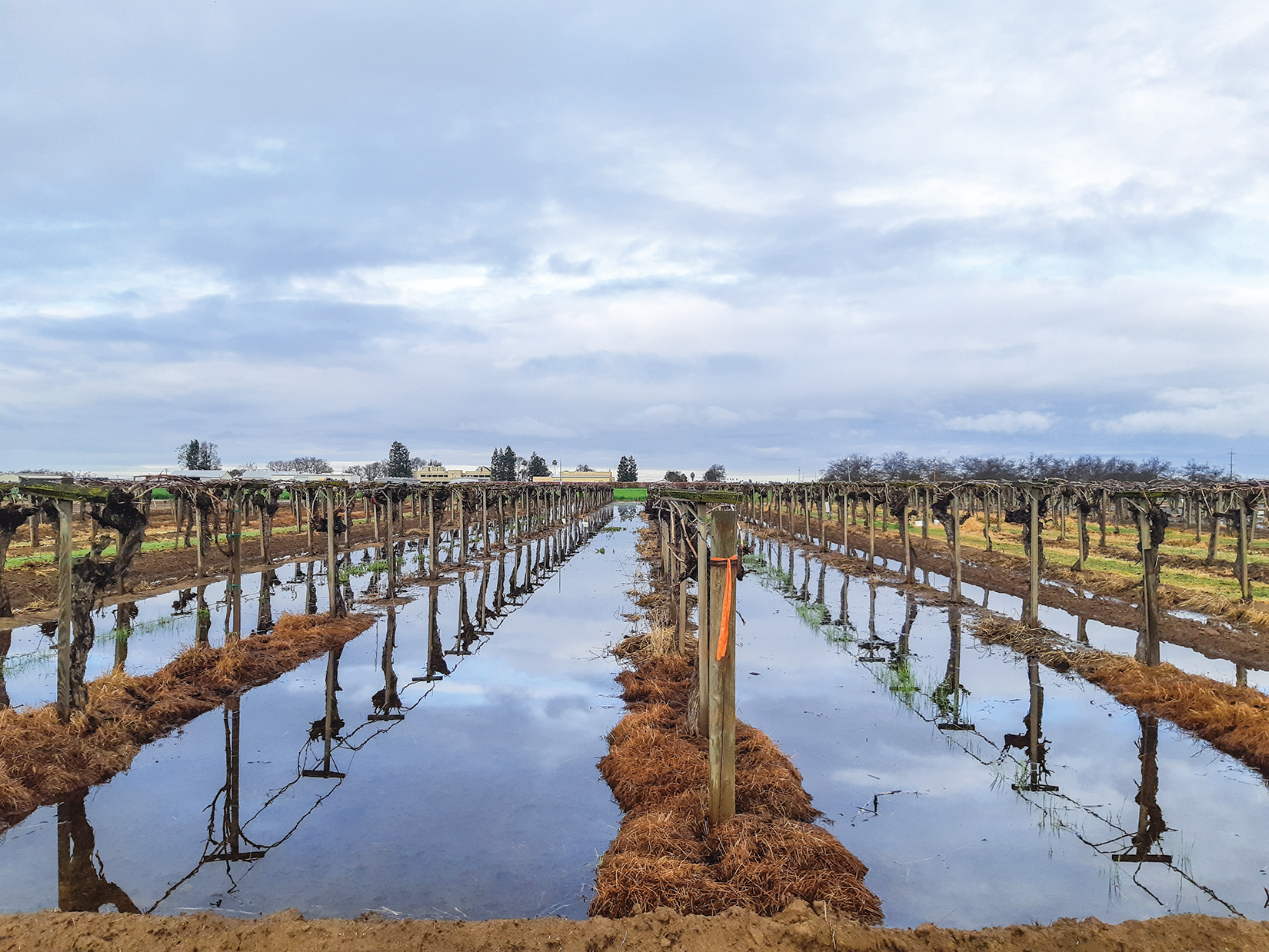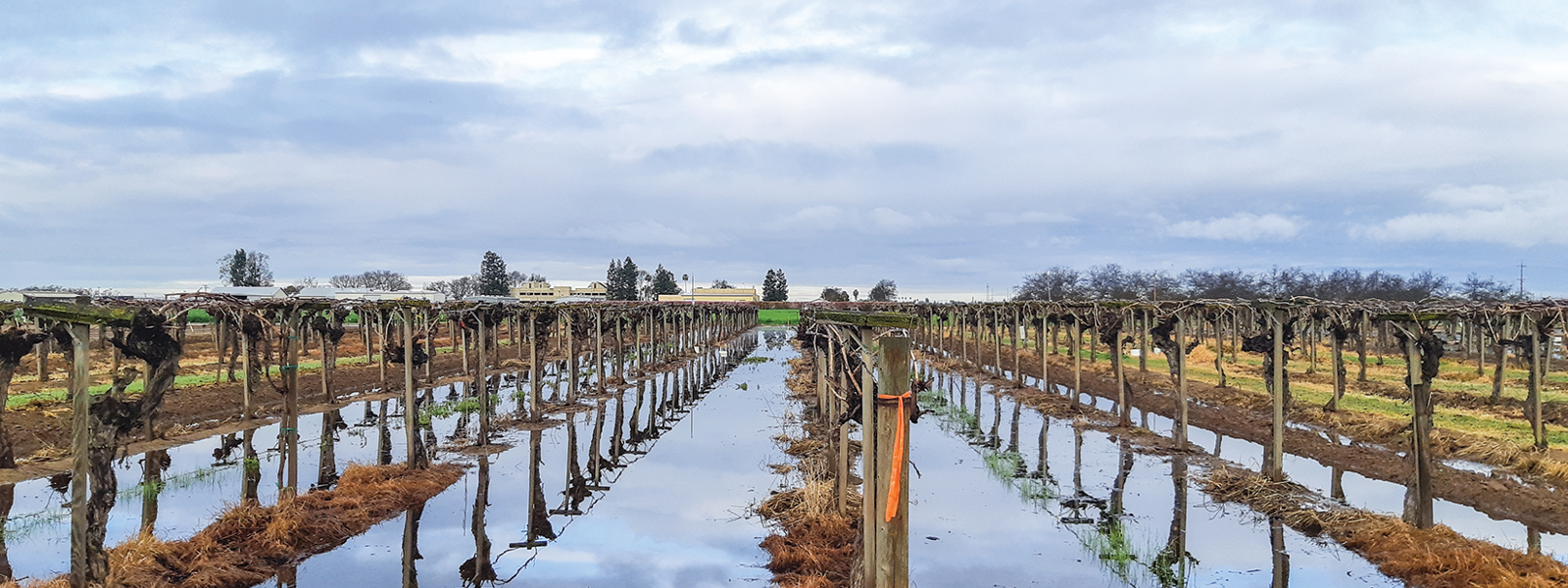Commentary: How managing flood flows can help rescue aquifers

Photo/Helen Dahlke/University of California, Davis
Following recent storms, University of California researchers flooded vineyards for managed aquifer recharge at the UC Kearney Agricultural Research and Extension Center in Fresno County.

By Thomas Harter, Mallika Nocco, Isaya Kisekka and Helen Dahlke
As a changing climate stresses water supplies, a key focus for California is on how to manage flood flows in ways that store more water for drought years while reducing risk to life and infrastructure.
A potential solution to this question is to enhance groundwater recharge, a natural process in the water cycle that leaks water from rainfall, rivers or flooded areas into the subsurface. Natural recharge is no longer enough to refill our overtapped groundwater reserves. But intentional, managed aquifer recharge, or MAR, can help reduce flood risk and store more water for dry periods.
Some MAR has been practiced in California for a hundred years by either injection of water directly into the aquifer or, more commonly, the diversion of stream water into percolation basins where water can seep into storage. To achieve rapid percolation of water from several inches up to several feet per day, managed recharge basins need to be situated over portions of the aquifer that ensure water is quickly distributed underground into the broader aquifer system to avoid water “traffic jams.”
California’s challenge is to greatly enhance and modernize our existing MAR infrastructure. Under existing conditions, a landscape such as California’s Central Valley—covering 13 million acres, half of which are irrigated for agricultural production—provides between 5 million acre-feet in dry years to as much as 15 million acre-feet of recharge in the wettest years.
To prepare for longer droughts with shorter, more intensive wet periods, California must find ways for storing additional millions of acre-feet of water into its aquifers in a matter of weeks to few months while untapped flood supplies last. We need three pillars to achieve flood managed recharge, or “Flood-MAR,” infrastructure at this scale:
1. We need more “supercharging” recharge sites. That involves identifying more places in the landscape that allow not only for rapid infiltration but also rapid distribution through natural underground sand and gravel channels that reach into the larger, less permeable parts of the aquifer system. In the Central Valley, so-called buried incised valley fills are among the most promising supercharging MAR sites. A hunt for those locations is ongoing, using 21st century aerial surveys of the underground and modern geophysical methods.
2. Our floodplains require reviving. Floodplains are natural places for MAR. They provide large tracts of land that are naturally accessible to flood flows when they occur. They also form living ecosystems to store water for weeks so water can percolate into the aquifer instead of running to the ocean.
3. It is important to engage with our farmers to build healthy soils and use agricultural lands for MAR. Some sandy farmland may be highly suitable as supercharging sites. Much agricultural land may lack such conditions. Instead, by their immense size of more than 9 million acres, California’s irrigated farmlands are key to facilitating the capture of large volumes of floodwater even if at mostly lower recharge rates, akin to millions of “trickle-charging” sites. Soil health practices such as cover cropping can be used to help increase infiltration.
We need to develop supercharging recharge sites as well as widespread, large-scale aquifer recharge in floodplains and agricultural lands through a trickle-charging infrastructure that will increase current MAR rates 100- to 1,000-fold. Wet years occur only three to five times in 10 years on average. It will take investments in research, learning and an enormous amount of equitable civic engagement. We must be creative and expeditious to improve water rights permitting for MAR and to facilitate joint reservoir and Flood-MAR operations.
We need to modernize and increase the capacity of our water conveyance infrastructure to move much larger water amounts to managed recharge sites. Perhaps most importantly, we need to engage with a large number of landowners to fully realize the recharge potential of the agricultural and natural landscape on those few occasions when the opportunity arises.
Recent decisions by Gov. Gavin Newsom and the California State Water Resources Control Board provide an opportunity for local water management agencies, groundwater sustainability agencies and landowners to proactively engage in finding creative solutions for more MAR, while increasing protection from unwanted floods. That helps in planning for the next wet winter for those MAR activities that need more time to build than we have at hand this spring.
While a challenging undertaking, the lower cost compared to more surface water storage and the large benefits to the state’s water supply, ecosystems and communities make this a promising future. It will not solve all the state’s water problems, but managed aquifer recharge is the most promising approach to shift our water supply onto a sustainable pathway with more security.
(Thomas Harter and Mallika Nocco are professors and Cooperative Extension specialists at the University of California, Davis, and Isaya Kisekka and Helen Dahlke are UC Davis professors. All study water management in agriculture. They may be contacted via thharter@ucdavis.edu.)




